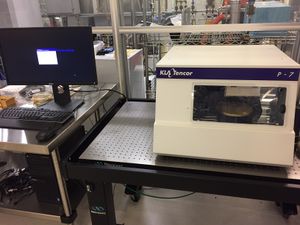Difference between revisions of "Step Profilometer (KLA Tencor P-7)"
Jump to navigation
Jump to search
(Copied from dektak page) |
(updated specs) |
||
| (9 intermediate revisions by 4 users not shown) | |||
| Line 1: | Line 1: | ||
| − | {{ |
+ | {{tool2|{{PAGENAME}} |
| − | |picture= |
+ | |picture=KLA-Tencor-P7_Photo.JPG |
|type = Inspection, Test and Characterization |
|type = Inspection, Test and Characterization |
||
| − | |super= |
+ | |super= Bill Millerski |
| + | |super2= Aidan Hopkins |
||
|phone=(805)839-3918x210 |
|phone=(805)839-3918x210 |
||
|location=Bay 4 |
|location=Bay 4 |
||
| − | |email=lingg_b@ucsb.edu |
||
|description = Surface Profilometer |
|description = Surface Profilometer |
||
|manufacturer = KLA Tencor |
|manufacturer = KLA Tencor |
||
|materials = |
|materials = |
||
}} |
}} |
||
| − | = |
+ | ==About== |
| + | The KLA-Tencor P7 profilometer is a stylus profilometer that drags a stylus across the wafer surface with controlled pressure, aligned via microcope, and measures the step-heights of surface features during the measurement. The system has a motor-controlled stage for X/Y/Rotation, and is typically used to measure step heights in single areas on various sample sizes frmo small pieces to 4-inch wafers. It can be programmed to scan multiple locations on a single wafer or 3D areas topography. |
||
| − | The Dektak VI is a profilometer for measuring step heights or trench depths on a surface. This is a surface contact measurement technique where a very low force stylus is dragged across a surface. The Dektak VI offers Windows based data acquisition, data analysis, and equipment control. The force of the tip on the surface is adjustable from .03 mg to 15 mg, allowing for the measuring of hard and soft surfaces. A stress measurement option is also included with this tool. The profilometer can measure to a depth of over 1 mm, allowing for direct measurement of MEMs type structures. Lateral resolution is tip-shape dependent and vertical resolution is 1A (when using the 6.55 mm range). The lateral resolution is limited by the tip shape. A video camera with variable magnification allows for manual placement of the stylus using the manual X, Y, Theta stage. Software analysis can determine roughness, average step height, etc. |
||
| − | =Detailed Specifications= |
+ | ==Detailed Specifications== |
| + | |||
| − | *20 mm maximum sample thickness |
||
| + | *Probe Tip: 2um radius and 60° angle |
||
| − | *.03 mg to 15 mg variable tip force |
||
| + | *Maximum wafer size: 6-inch |
||
| − | *Height/Depth measurements to 1 mm |
||
| + | *1D Profile and 2D Raster Scanning |
||
| − | *1 A vertical resolution at 6.5 um full scale |
||
| + | *Automated Measurement Routines |
||
| − | *Standard stylus radius is 12.5 um, optional 2 um stylus available |
||
| + | |||
| − | *6 inch stage diameter with manual controls for moving and leveling |
||
| + | ==Instructions== |
||
| − | *Software data leveling and other analysis including stress |
||
| + | |||
| − | *Full GUI-based Windows control and data storage and exporting capability |
||
| + | *[[KLA Tencor P7 - Basic profile instructions|KLA Tencor Operation Procedure]] |
||
| + | *[[KLA Tencor P7 - Saving Profile Data|Saving+Extracting Profile Data]] |
||
Latest revision as of 23:06, 4 April 2024
| ||||||||||||||||||||||||||
About
The KLA-Tencor P7 profilometer is a stylus profilometer that drags a stylus across the wafer surface with controlled pressure, aligned via microcope, and measures the step-heights of surface features during the measurement. The system has a motor-controlled stage for X/Y/Rotation, and is typically used to measure step heights in single areas on various sample sizes frmo small pieces to 4-inch wafers. It can be programmed to scan multiple locations on a single wafer or 3D areas topography.
Detailed Specifications
- Probe Tip: 2um radius and 60° angle
- Maximum wafer size: 6-inch
- 1D Profile and 2D Raster Scanning
- Automated Measurement Routines
